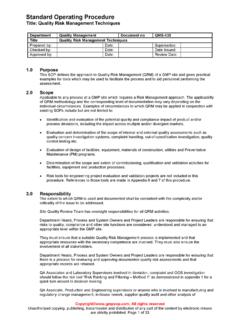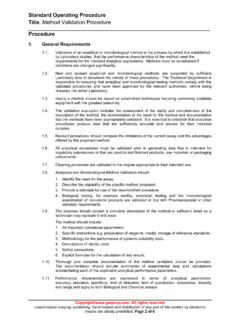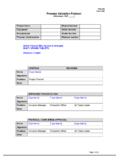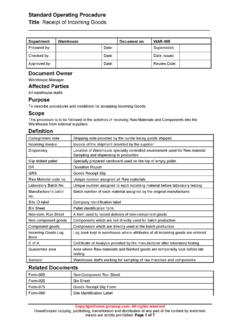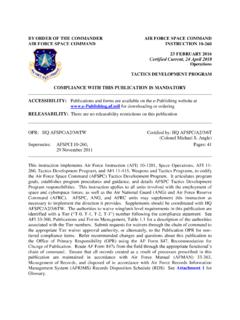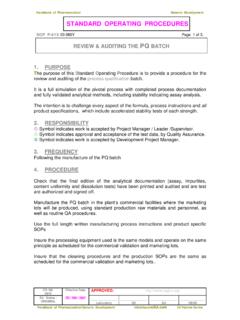Transcription of Standard Operating Procedure - Gmpsop
1 Standard Operating ProcedureTitle:HPLCM ethod Development & validation ProcedureCopyright All rights reservedUnauthorized copying, publishing, transmission and distribution of any part of the content by electronicmeans are strictly of7 ProcedureGeneralThe validation of an analytical method is the process by which it is established that the performancecharacteristics of the method, such as Precision, Accuracy, Specificity, Linearity, Limit of Detection (LOD),Limit of Quantitation (LOQ) and Robustness meet the requirements for the intended SOP refers specifically to HPLC. However, the same principlesmay be applied to validations of othertypes of analytical reference materials with documented purity should be used to perform the optimum wavelength for a method can be found by acquiring the chromatographic data on a PDAdetector over a large wavelength range, ( 200-400nm).
2 The optimum wavelength is the wavelength,which maximises the response for all the components of interest, but is outside the absorbance for themobile phase. Before validating an HPLC method, its Specificity must be determined. If the method doesnot comply with the Specificity requirements, the method must be modified until the acceptance criteria aremet. Hence it is essential that the Specificity be adequate, before Precision,Linearity and Accuracy, etc. used in determining Factor (k ) is defined by the equationk = VR- VO------------ VOwhere:VR =the distance along the baseline between the point of injection and a perpendiculardropped from the maximum of the peak of distance along the baseline between the point of injection and a perpendiculardropped from the maximum of an unretained , RDetermine the resolution between adjacent peaks, A and B, using the following equation:R = VB- VA------------------1/2 (WA + WB)whereV =retention time of the peaks (expressed in mm)W =peak widths at the baseline of tangents drawn on the peak (mm).
3 Standard Operating ProcedureTitle:HPLCM ethod Development & validation ProcedureCopyright All rights reservedUnauthorized copying, publishing, transmission and distribution of any part of the content by electronicmeans are strictly of an analytical method refers to the degree of agreement among individualtest resultsobtained from multiple sampling of the same homogeneous sample. Precisionmay be considered at 3 levels: Repeatability, Intermediate Precision and precision of a method is usually expressed as the variance, Standard deviation orcoefficient of variation of a series of may be obtained by:1) Repeatedly applying the analytical method to multiple samplings (at least 6) of ahomogeneous sample at 100% of test concentration,or;2) at least 9 determinations covering the specified range for the Procedure ,( 3 concentrations, 3 replicates each).
4 The Standard deviation of the results must be 2% of the mean for the method to meet precision Precision. This establishes the extent to which random events influence theprecision of the method, within the one laboratory. Typical variations to be studied are:different days, different analysts, or different pieces of refers to inter-laboratory trials. As a general rule the reproducibility shouldbe within +/- 2% between laboratories for active drugs and 10% for degradation may be defined as the closeness of an individual test result to the true test resultvalue. Thus, accuracy is a measure of the exactness of the analytical method.
5 The resultsof a given method may be high in accuracy but low in precision, and vice versa. Accuracymay often be expressed as percent recovery by the assay of known, added amounts ofanalyte to the inert can be determined by preparing a matrix of the ingredients of the product with theexception of the active component. The active component is then added or spiked inknown amounts usually ranging from 75% to 125% of the dosage strength on at least5 levels (25%- 125% for dissolution studies). The recovery of the known amount is minimum of 3 concentrations should be studied, 3 injections per concentration. Theaccuracy of an analytical method is the closeness of test results obtained by that method tothe true or theoretical Accuracy = Experimental Assay- Theoretical Assay x 100 Theoretical accuracy acceptance criteria are> 98% and< 102%.
6 Typical % RSD acceptance criteria (over all concentration levels) is< 2%. validate the accuracy of a method, the analyst must have a Standard material ofcharacterised purity in order to know what response to expect in the test of Detection / Limit of the quantitationof impurities and degradation products, linearity studies should becarried out in the presence of the drug substance. Such studies should be extended to lowconcentrations to experimentally define actual Limits of Detection (LOD) and Limits ofQuantitation (LOQ).
